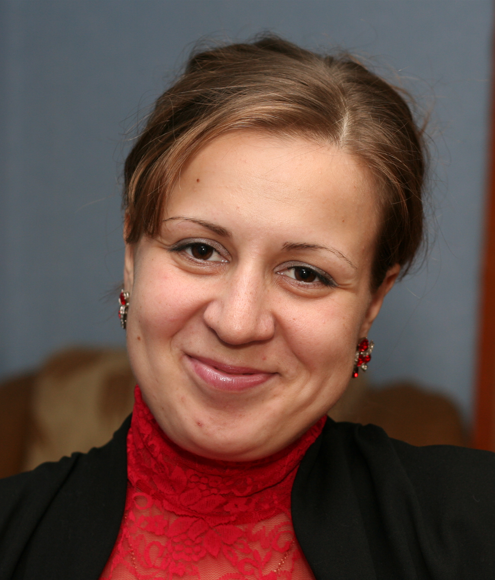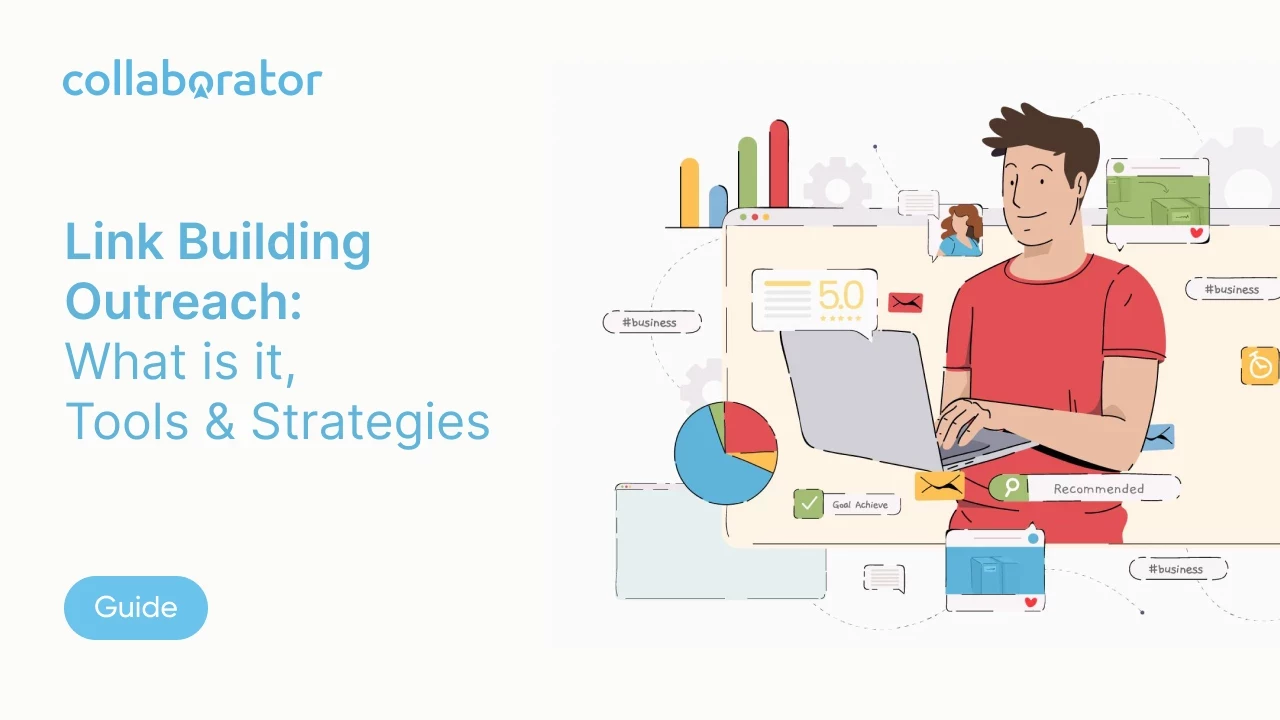
- What is Outreach Link Building?
- Why is Outreach so Important for SEO?
- 5 Best Link Building Outreach Strategies
- Link Building Outreach Process
- How to Make Your Link Building Outreach More Successful
- Top Link Building Outreach Tools to Use
- Collaborator is Your Best Assistant for Outreach
- FAQ about Link Building Outreach practice
- Conclusion
Your website is full of great content, but search engines are slow to push it to the TOP? Perhaps it's a lack of proper promotion. Writing an accurate press release or a good article is not enough — you need to promote it. And one of the main strategies for content promotion SEO success is link building outreach.
In this article you'll find a comprehensive guide to link building and outreach strategies, along with practical advices and links to popular tools to help you get your site on the top.
What is Outreach Link Building?
The number of external links is not the only but very important indicator of content quality. If you are being referenced, it means you have credibility! At least, that's what search engines think.
Find more detailed information in our article on What is link building?
Outreach is the process of gaining links through direct communication with representatives of the target sites.
This is primarily communication, which can be done through the different channels available to the outreach worker: email, social media, telephone, direct contact at events, and so on.

Always remember: it doesn't matter how you get the link. What matters is the result: the link appears on the site. The most important thing, rather, is where and how it is placed.
This is what link building and outreach actually are. You talk about your activities and encourage third-party site owners to link to your material. With a little diplomacy, you get links for free or buy backlinks cheap to your page — and a better chance of being seen as a top performer.
Why is Outreach so Important for SEO?
Not so long ago, search engine algorithms were only concerned with the number of external links. Recently, however, not only the number of links has become important, but also their quality. A link from a large, reputable site is much more valuable than a link from an unknown blog from a week ago (with all due respect to newbie bloggers).
However, you have to earn the right to put a link on someone else's site. At least — to offer the owner of the site, which should link to you, something interesting and original. What can it be? How can you interest third-party site owners?
5 Best Link Building Outreach Strategies
There are many link building outreach techniques. Here are the most popular ones:
- broken link building;
- skyscraper method;
- guest posting;
- link exchange;
- digital PR.
What are the principles behind these link building outreach strategies? Want to know more? Read on!
Broken link building
You find a broken link that doesn't lead anywhere on sites on your field (you can do this with special programs, such as Screaming Frog, Ahrefs, and so on).
Find detailed instructions on how to do it here:
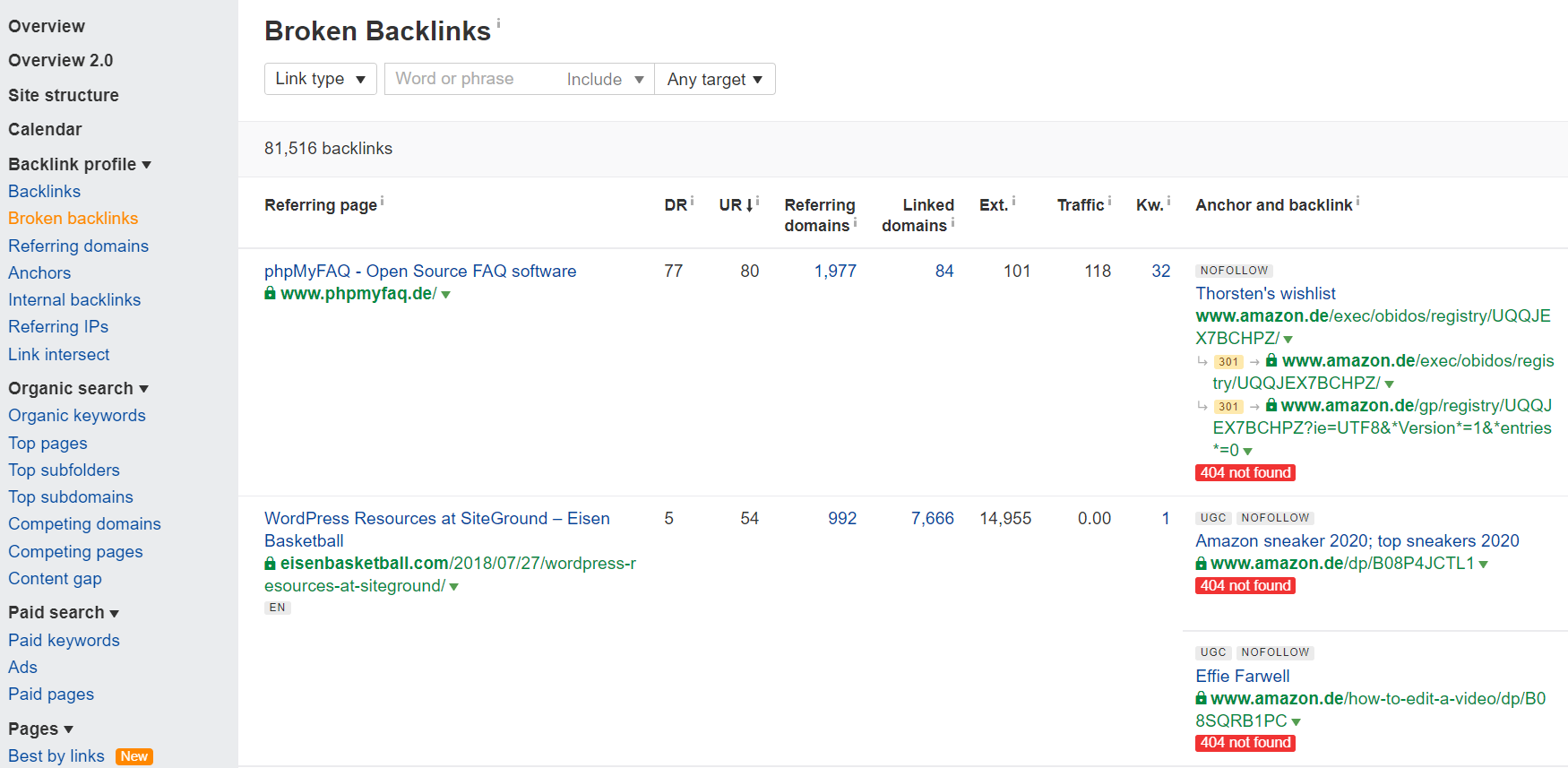
Then you contact the administrator or owner of the site and offer to link to your page instead of non-working ones of other sites. It is beneficial for both sides — you get a working link, the site — the actual content.
Skyscraper method
This method is described in detail by Brian Dean. He considers it one of the most effective and fastest techniques.

Dean says traffic to his page increased by 110% after applying the skyscraper method
The essence of the skyscraper method:
- Search for ready-made pages on your topic, for which there are many valid links. There are special tools for this, such as Ahrefs.
- Make your own content on your site on the same topic, but better quality: more voluminous, more detailed, better designed and so on.
- Provide this article to the referring sites as a replacement.
Figuratively speaking, you find existing links and offer webmasters to replace their content with higher quality and more interesting one. Webmasters are more willing to update existing links than to create new ones. Therefore, the skyscraper method works with a “warmer” audience.
Guest posting
One of the most popular and effective strategies. You find a popular platform for your topic and ask the owner or administrator to post your article.
However, this only works if you already have some name and credibility. But what if your page is not yet that popular? That's when a guest posting marketplace can help you. In the catalogs you can find a suitable, relevant resource that will be ready to publish your guest post.
By the way, in the Collaborator catalog, you can find more than 19,000 sites in 36 themes.
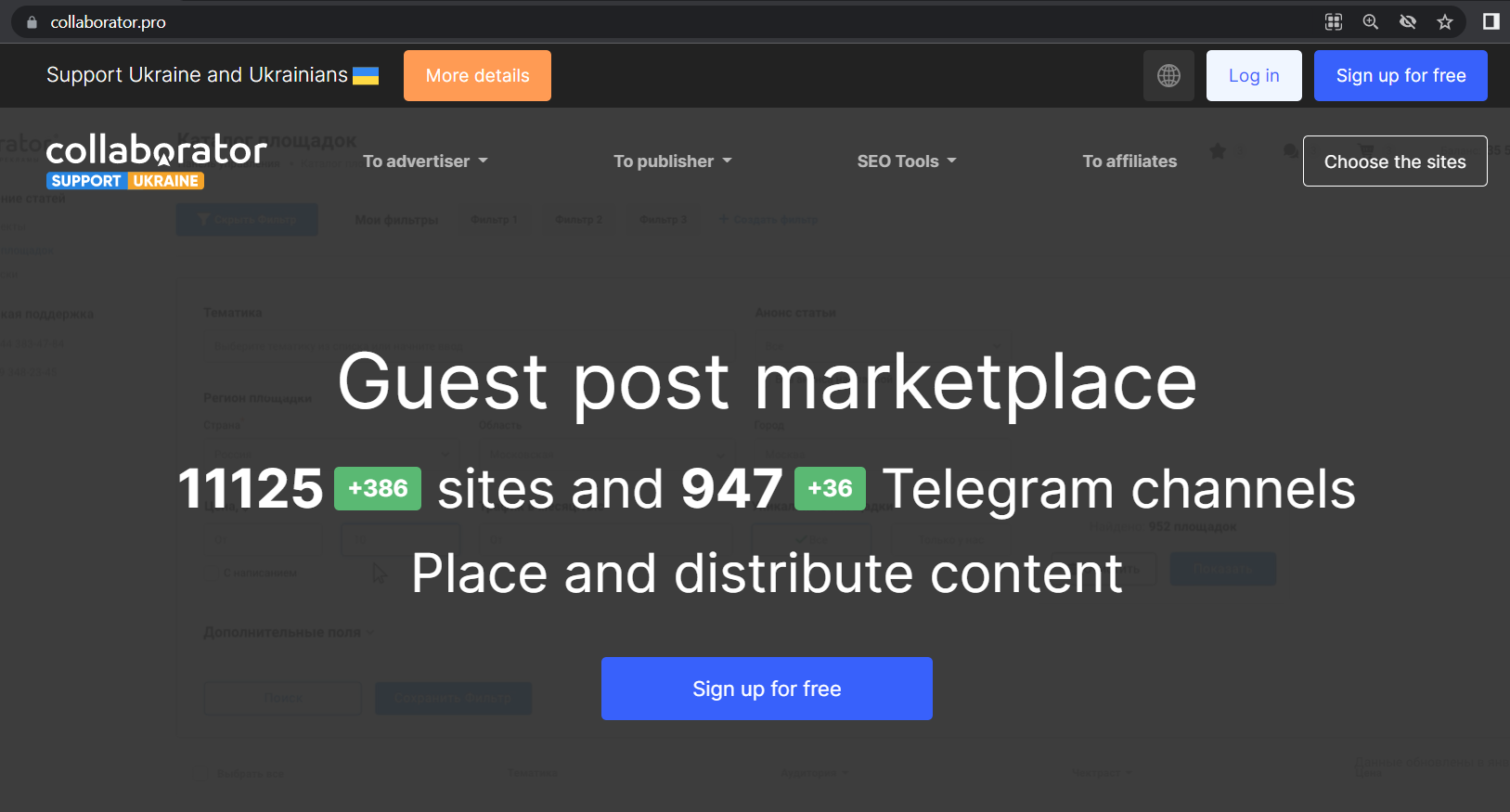
You will always be able to choose the right one for your article or a press release. With a simple filter, you can immediately estimate the number of donor sites in your niche.

Link exchange
Using this link building strategy, you also approach platform owners with an offer — they host your link and you host their link. This is a relatively simple and convenient method. However, you should be careful with it: too many reciprocal links may result in a lower search ranking. Below you'll see an example of an incorrect link.

Digital PR
PR and SEO marketing are different but overlapping fields. SEO often borrows from PR techniques and tactics, particularly in link building. In simple terms, digital PR is about promoting the content and enabling sites to link to it. Your brand is presented, advertised, and promoted and links are generated in parallel.
There are also different variations of these strategies in link building. For example, guest posts can be “cold”: you write to an author or company with the expectation that your content will be considered in the future.
Broken links may have previously led to your page, but for some reason no longer work. In such a situation, it is appropriate to contact the site administrator and ask them to restore or update the link.
An option for guest posting is to include your link in a themed selection — e.g. “top 10 SEO resources”. This is a simpler but no less effective way.
Note that all of these strategies are “white hat” methods. Even the simplest among them contribute to improving content quality.
Read more about link building strategies and tactics in our full guide.
Link Building Outreach Process
Whichever strategy you choose, the link building outreach process will be essentially the same.
- Finding and evaluating donor sites.
- Getting and verifying owner's contacts.
- Composing and sending a personalized letter.
- Communication management. Tracking the status of sent emails.
- Summing up the results.
This doesn't sound too complicated. However, each step has its own specifics.
Finding and evaluating websites to publish your content
The first thing to do is to determine which sites you plan to link to.
For this, you need to make a selection of reliable and relevant sites that are correspond to your theme. To choose a really reliable site, you should consider the following indicators:
- popularity — the site should have a high traffic and active attendance;
- nature of the links — existing links should be relevant;
- citability — the site you are interested in should have a large number of links;
- trust flow — links leading to the resource should be of high quality;
- attractiveness for search engines - with good indicators of domain authority, trust, etc.
You can find a donor site manually in Google with the help of search operators
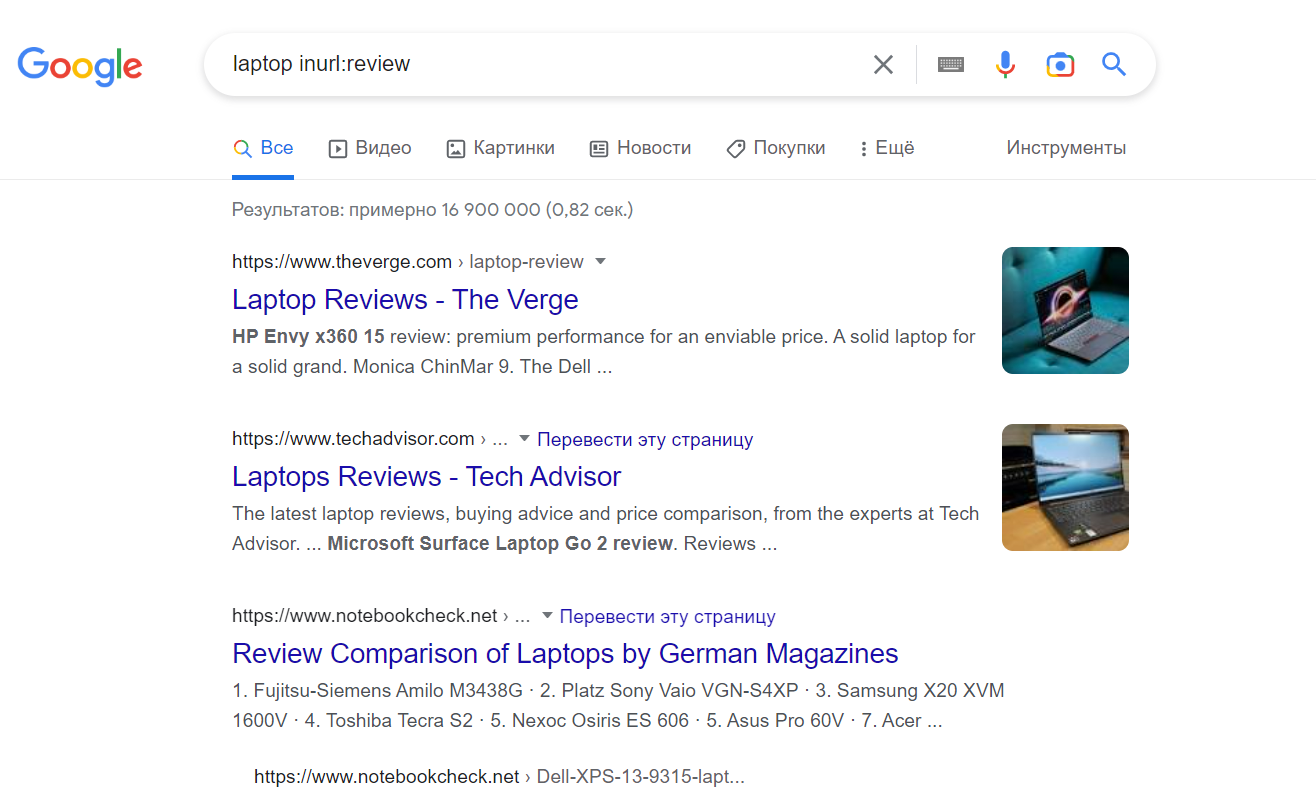
Or use special tools, for example, Ahrefs

Getting contacts & email verification
Emails are ideal. Preferably it should be personal, to increase the chances of your email being seen and read. Search for email addresses on LinkedIn and personal websites, for example.
Manual collection of contacts is considered the most effective.

Contacts can also be found using special tools such as Hunter, Voila Norbert, Anymail Finder, and others.

You should also check emails for functionality and relevance. Because often specified contacts no longer work. You can do it with the help of special tools: Snov.io, Reply.io, Zerobounce.net, Pabbly.com ect.

Composing the letter
You have found the addressee and the email. Now you need to write a letter! And one that won't go to spam, and that you won't want to delete after the first few lines.
When communicating your request, be brief and discreet. Avoid long introductions, be polite but decisive.
It is advisable to mention the benefit your recipient might receive in exchange for the link. For example, relevant content or help with promotion.
How to make the letter more attractive to the recipient:
- Pay attention to the layout of the letter. It should have signatures, contacts, addresses, and other elements that prove you are a human being, such as a professional email signature to enhance credibility and make your communication more personal.
- Make your letter as personalized as possible
- address your recipient by name;
- mention something specific to their work or area of expertise;
- research their social networks, see what they write about and what they are interested in; if possible, mention it in the letter. - Have a subject line. Pick good email headlines! They should be succinct and informative, like “Bad link”. This makes it clear to the recipient at a glance why you are writing to them. If you have an open rate of less than 5% then change the subject line.
Communication management
After sending a letter, you need to keep track of its status. Surely, sending and tracking a huge amount of emails is not an easy task. Using special software will save you lots of time. Here is what an outreach manager from Hunter says about it.

Even if you get (or don't get) a clear response, you need to keep working.
There are four possible responses to your letters:
- acceptance;
- rejection;
- temporary rejection;
- ignoring.
Acceptance is the preferred option; if your offer is accepted, you should write a letter as soon as possible to clarify the conditions and deadlines, send the actual link (if it is a link exchange), and so on. And be sure to thank them for posting your content!
Rejection is quite rare, but if you do get rejected, it's worth finding out the reasons. Ask why your content was not suitable and which would have been preferred. This will help you make a better offer next time.
If you have been temporarily rejected on any conditions, find out more about those conditions and ask when it would be appropriate to make an offer again.
If there is no response at all, don't be embarrassed to remind yourself. Send a second letter 3-4 days later; if there is no response, send a third in another 3 days. Be sensitive and polite, but don't be afraid to state your intentions.

Results analysis
Analyzing your work and drawing conclusions will make it much easier for you to continue with your link building campaign.
In your analysis, ask yourself questions such as:
- How many links did your page get? How many of them are direct (directly from the recipient) and how many are indirect?
- Is your content being reposted on social media? The more reposts, the more indirect links;
- How effective are your keywords? Note that pages with keywords should receive higher rankings.
Special tools will help to automate the processes of management and analysis of newsletters. Below you will see screens of work with one of them.
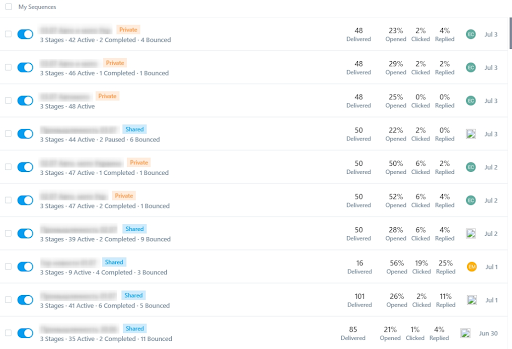
How to Make Your Link Building Outreach More Successful
Outreach for link building is not an easy activity, with success depending on many factors. They include the relevance of the content you offer, how researched the field is... even the mood of the person you're writing to.
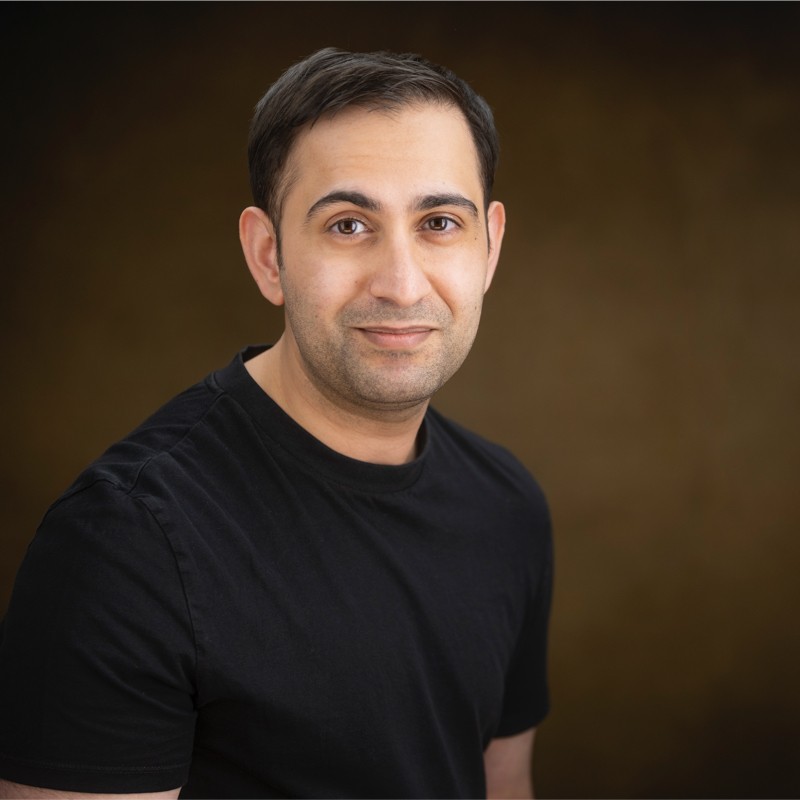
11 basic tips “how to do outreach link building” can help you significantly improve your chances of getting a link.
- Use link building outreach tools. Try to make the process as automated as possible — this will save time and effort.
- Use a content exchange. They make it easy to find the sites you need, without wasting extra time. For example, with Collaborator you can quickly and safely place your material on reputable platforms.
- Analyze your KPIs on each stage. Collect data, keep tables, study your strengths and weaknesses. Do a little case study to improve your results in the future.
- Keep all the information in one place. Prepare tables and documents, lists of websites, contacts and the like in advance and keep them handy.
- Pay attention to the quality of the site. Do not take everything — poor selection of sites for links can have an adverse effect on your own ranking.
- Find the right person. If you are interested in a large platform, there is no point in writing to the owner of the platform — he is unlikely to do this sort of thing. You will need a site administrator who will oversee the site directly.
If your goal is a private blog, on the contrary, you need to write to the owner. He is most interested in popularity and promotion. Suggestions of this kind should be sent to him personally. - Demonstrate your value. Simply asking for your link to be published is useless. Explain why it will benefit the site, and what it can do to improve performance. Prove that your content is worth publishing.
- Use social media. If communication by e-mail has failed, write on your social media profiles and messengers.
- Take care of the content. Quality, interesting article should be prepared in advance and always kept at hand. Influencers will certainly be interested in what you have to offer. Better still, you should always have something to showcase.
- Aim to earn dofollow links. It's not easy, but it always pays off.
- Use descriptive & relevant anchor. Anchor text is the copy users click on to open your links, acting as a call to action (CTA). But they're also a way of telling search engines what the page is about. To get the most out of your anchor text, it should be relevant to the page it links to.
These are the best practices, but not the only ones. Remember to study the theory and analyze your work.
Collaborator marketer Margarita Nesterenko in the Email outreach article described useful recommendations for preparing effective emails and productive communication with site owners:
- how to outreach to get your emails answered
- how to do A/B testing for cold email campaigns
- how to create outreach emails that convert
- and other issues
Top Link Building Outreach Tools to Use
There are link building outreach tools available to make the process easier through every step. They can help you:
- collect a database of outreach sites (Ahrefs, JustReachOut as examples);
- quickly find and organize contacts (BuzzSumo, GroupHigh);
- send mass emails and monitor the outcome of the process (BuzzStream, NinjaOutreach).
Some of these software packages we will look at in more detail.
Ahrefs
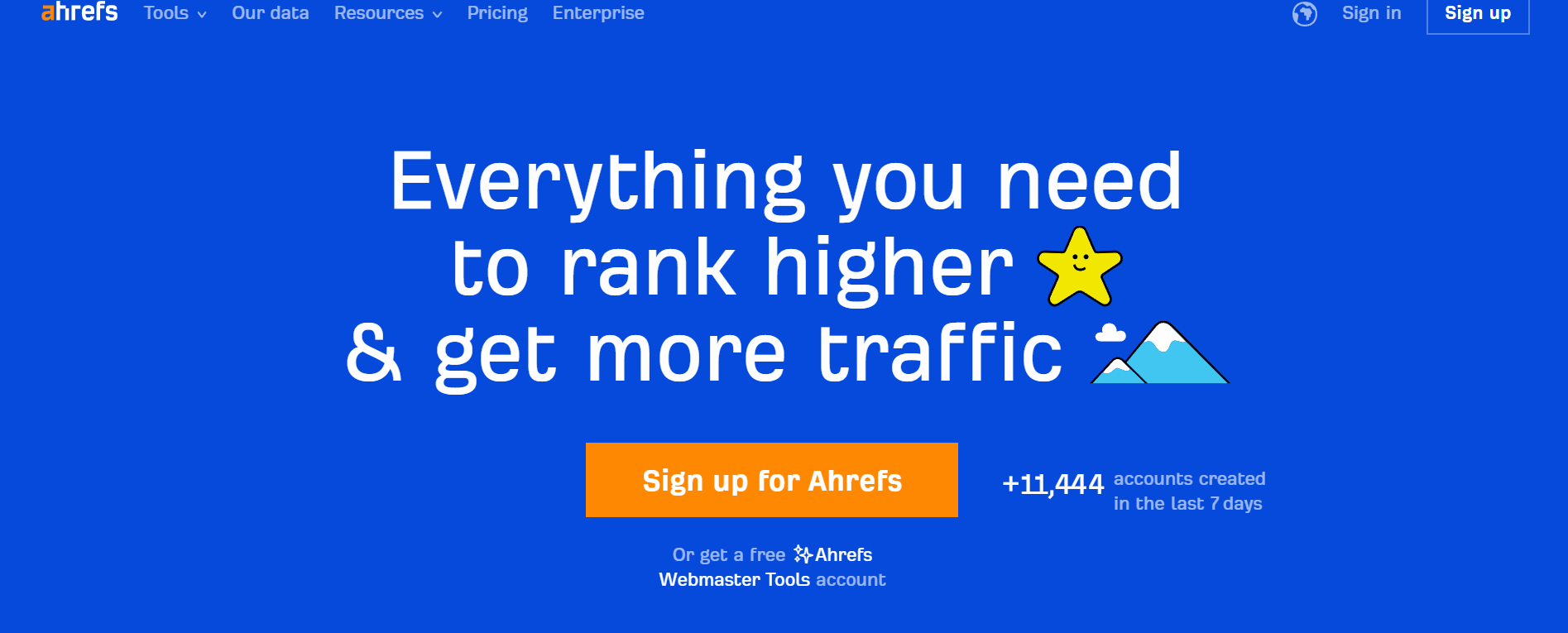
Ahrefs is one of the largest databases that collects a variety of information, from the frequency of keywords to the number of backlinks. The link building outreach service helps you find backlinks, analyze keywords, track rankings, identify public content and much more. Read our overview of Ahrefs webmaster tools.
Ninja Outreach

An effective tool for finding potential Influencers. You can use it to find interesting contacts on Instagram, YouTube and Twitter. It also helps you to compose email templates and track the results of communication.
You can use the website version, or you can install the Ninja Outreach google app and find your contacts while you search.
BuzzStream
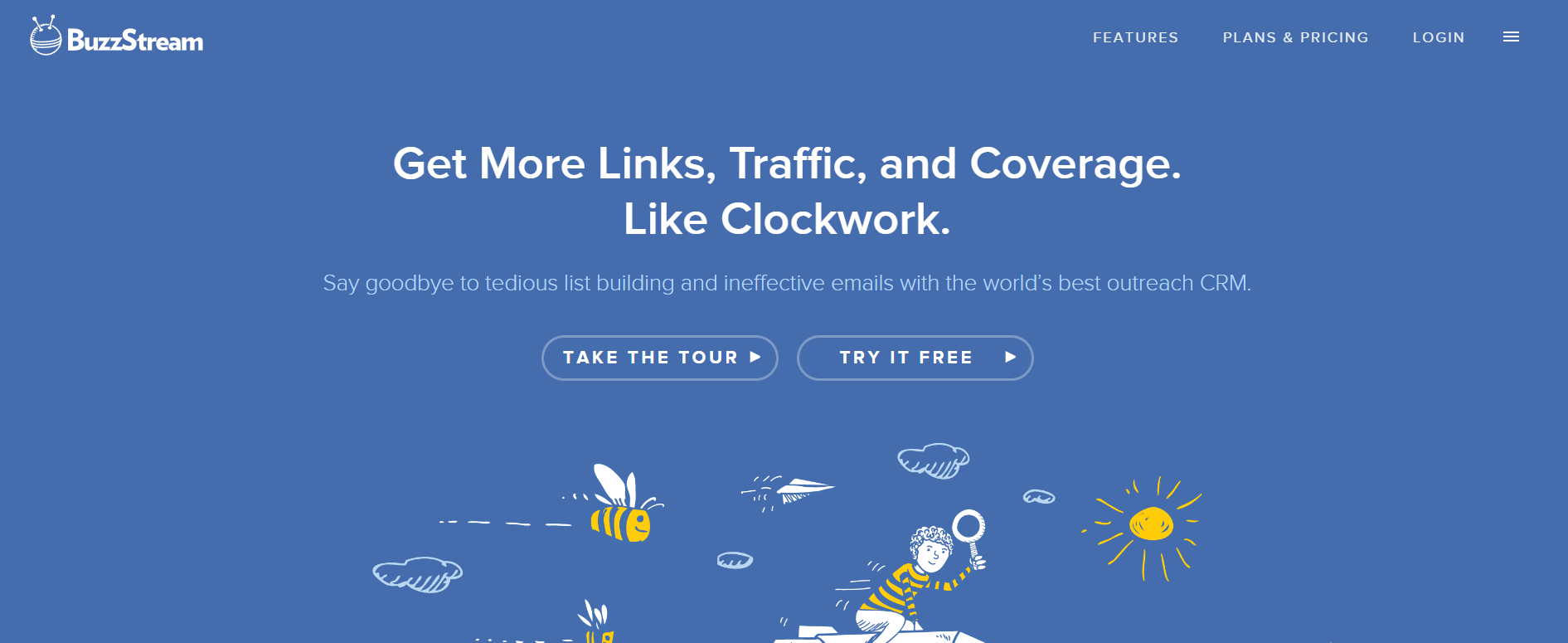
A great tool for maintaining and organizing your database, and analysing and comparing the results of their work. Allows you to manage a list of contacts and companies, find contact information, track email correspondence and Twitter posts, monitor process efficiency and much more. Available as an app in Google Chrome.
BuzzSumo
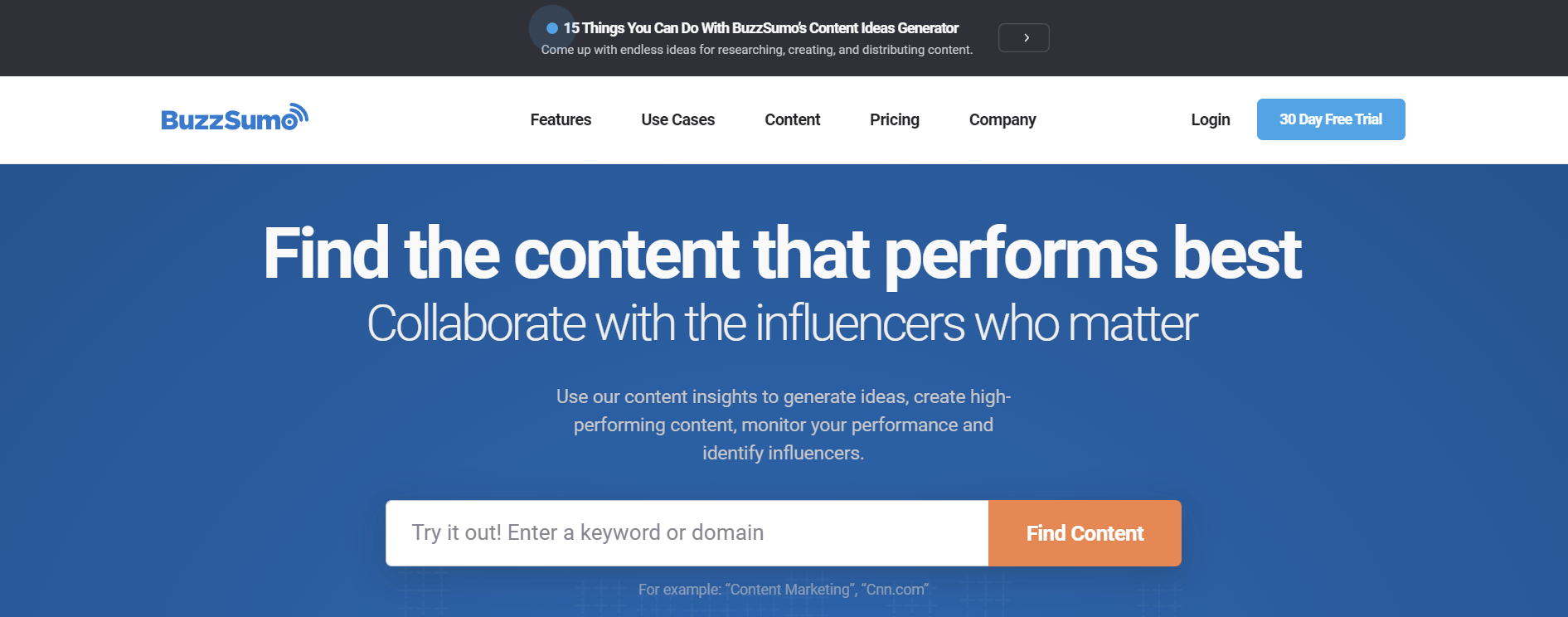
Of all such tools BuzzSumo can be called the most complex and advanced. But it's also the most effective! BuzzSumo doesn't just look for Influencers — it tracks links and mentions.
It identifies where your brand has been mentioned without an accompanying link. Tracks the distribution of similar content by your competitors. Helps keep an eye on trends. For the link builder, it's an indispensable tool.
Also, check out our article on the best link building software tools.
Collaborator is Your Best Assistant for Outreach
A promoter has to deal with a variety of tasks — from choosing the right site to communicating with influencers. The Collaborator platform is a universal tool that helps with most of these tasks.
The aim of Collaborator is to make backlinking as easy and efficient as possible. The platform helps website owners and outreach workers find each other and get a good and safe deal.
Advantages of Collaborator:
- first of all, it is the high speed of all processes: searching for the right sites, finding the owner, getting a response (because registered site owners are also interested in cooperation), posting materials, processing deals (averaging only 2 days) and so on;
- wide choice of high-quality sites. Many sites in the directory can be filtered by traffic, DR and other SEO parameters. There is also an internal rating based on feedback from previous customers;
- integration with Ahrefs, Serpstat. See all the necessary metrics right in the Collaborator interface. You can create a preliminary list of sites for placement without switching to other tools;
- security. All processes on the platform are secure: the exchanger makes sure that the link is published on the site and stays there as long as necessary;
- transparency and clarity. Sites immediately indicate where the article will go;
Using the Collaborator is comfortable and easy. The intuitive interface will help you navigate the catalog and quickly order the placement of a guest post with a link. And the special functionality of the Master account will come in handy when working with entire outreach teams. Besides, here you can find an on page optimization Checklist which includes all steps you should take to audit and improve your on-page SEO.
FAQ about Link Building Outreach practice
Can my business do SEO outreach?
Knowing how to outreach for link building is absolutely essential for modern business. However, if you lack the time or other resources, you can turn to specialist companies who will do the referencing for you.
How to choose outreach link building services that suit my business?
The best way to find out more about outreach link building services is to look at reviews. Check user reviews, pay attention to the company's rating and don't forget to check if the service has a contact page — trustworthy sites allow you to get in touch with their team.
Can I use link building outreach templates?
Yes, you can. It's a great way to save time and effort. There are quite a few resources with ready-made samples. Most importantly, don't forget the personalisation elements.
Are link building social media outreach good for SEO?
External links are the most important element of page promotion, so link building outreach strategy has a lot to do with it. The right links can really make miracles happen! So make sure you pay attention to them.
What is better: contact the outreach link building agency or do it yourself?
Doing manual outreach link building, you are in control of the process and better able to navigate the information coming in. However, it is time-consuming and labour-intensive, so it may be better to outsource building links to a reliable link building agency. There are many companies who can be trusted to produce quality links, and you can always hire a competent person for this purpose.
Conclusion
Link Building Outreach of your site is a complex process. It requires extensive knowledge and sometimes non-trivial skills. Keeping track of everything yourself and performing all tasks manually is a hard and thankless task. Fortunately, there are tools that can save you time and effort. The Collaborator is just such a tool, and handles a variety of tasks, from site selection to communication with influencers.
